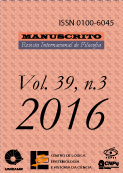Abstract
In this article I argue that the methodology in the Johannes Kepler´s work is guided by two principles of Pythagorean nature, they are: (i) sameness is made known by sameness, and (ii) harmony arises from establishing a limit to what is unlimited. By way of hypothesis, I present a general outline, which includes those principles, and I indicate how they are present in Kepler’s investigations. I examine two particular cases in the light of that schema.References
ARISTOTLE. “Metaphysics”. Transl. by McKeon, New York: Random House, pp. 689-934, trad. 1941.
ARISTOTLE. “Metaphysics”. “De Caelo”. Transl. by McKeon, New York: Random House, pp. 398-469, trad. 1941.
BUCHDAL, G. “Methodological Aspects of Kepler´s Theory of Refraction”. Studies in History and Philosophy of Sciences, no. 3, pp. 265-298, 1972.
CAROLYNE, E. (editor). “Historical Perspectives on Peirce´s Logic of Science”. A History of Science. Berlin: Mouton Publishers, 1985.
COPERNICUS, N. “De Revolutionibus orbium coelestium”. Norimbergae: Johann Ptereius, 1543. Transl. by Charles Glenn Wallis, Chicago: Encyclopaedia Britannica, Inc (Britannica Great Books, vol. 16), 1543/1955.
EUCLID. “The thirteen books of the Elements”. Transl. by Thomas Heath, New York: Dover Publications, INC, trad. 1956.
HEATH, THOMAS SIR. “A history of Greek Mathematics”. New York: Dover Publications, Inc. Vols. 1, 2, 1981.
KEPLER, J. Astronomia nova. Heidelberg, 1609. Transl. By Jean Peyroux, Paris: Librairie A. Blanchard, 1609/1979.
KEPLER, J. Mysterium Cosmographicum. Württtemberg, 1596. Trans. By A. M. Duncan, Norwalk : Abaris Books, 1596/1999.
KEPLER, J. Epitome astronomiae copernicanae. 1618-1621. Transl. by Charles Glenn Wallis, Amherst: Prometheus Books, 1618/1995.
KEPLER, J. Harmonices Mundi. Linz: Johannes Plank, 1619. Transl. by E. J. Aiton, A. M. Duncan & J. V. Field, 1619/1997.
KEPLER, J. Ad Vitellionem Paralipomena, Quibus Atronomiae Pars Optic. Francfurt: Apud Claudium Marnium & Haeredes Ioannis Aubrii, 1604. Transl. by William Donahue, Santa Fe: Green Lion Press, 1604/2000.
KEPLER, J. “Dioptrice”. Transl. by Rolf Riekher, Frankfurt: Verlag Harri Deutch, pp. 441-526, 1611/2008.
LA RUE, J. (editor). “Aspects of Medieval and Renaissance Music”. London: Oxford University Press, 1967.
PEIRCE, C. S. “Johann Kepler”. In E, Carolyn (editor) (1985), Part. I, pp. 290-295.
PROCLUS. A “Commentary on the First Book of Euclid´s Elements”. Leipzig: Gottfried Friedlein, 1873. Transl. by Glenn R. Morrow, Princeton: Princeton University Press trad. 1970.
VOELKEL, J. R. “The Composition of Kepler´s Astronomia Nova”. Pinceton: Princeton University Press, 2001
WERNER, E. (1967). “The last Pythagorean musician: Johannes Kepler”, in J. La Rue, (editor), pp. 867-888, 1967.
ZAISER, H. “Kepler als Philosoph”. Stuttgart: E. Suhrkamp, 1932.

